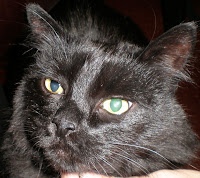
Tommy is another of our senior patients. He is a fifteen and a half year old long-haired indoor cat. A year and a half ago at his exam, I saw that he had dental disease and multiple teeth with lesions called Feline Odontoclastic Resorptive Lesions (FORL) so we scheduled him for a dental cleaning under anesthesia. His blood and urine tests were completely normal.
At his dental cleaning, his dental radiographs revealed that the body was resorbing many of the roots of the teeth. This is a common problem in cats, and while we do not know what causes this resorption, we do see it frequently when there are FORLs. I extracted four of Tommy's teeth and sutured the gums closed.
Because his owners had noticed that Tommy seemed to have some discomfort in his hind end, we then took radiographs of Tommy's hips and lower spine. The radiographs are the best way to evaluate a cat for arthritis. I noted some mild changes in the bones around his hips. The cartilage is not visible on the radiographs but even mild changes in the bones indicate that there are changes to the health of the joint.
Tommy did very well after his dental procedure and started eating well immediately. I prescribed a glucosamine/chondroitin product for him to help his joints but he would not eat it in his food. Three months later, he started vomiting and his owners brought him back into the clinic. He was constipated and had a thickened section of intestinal tract. His anal sacs were full so I expressed them out and started him on lactulose, a stool softener. He did well on this and I could no longer feel the thickened intestine at his progress exam a week later. I also started him on Fortiflora, a probiotic, at this time to keep his intestinal tract healthy.
A month later, Tommy was back in the clinic. He seemed very uncomfortable in his hind end and would not jump. He reacted strongly to my manipulation of his hips so it appeared his arthritis was worsening. I prescribed a non-steroidal anti-inflammatory medication and a gel with glucosamine. He immediately improved with the medication and was moving around much better.
Two months later, Tommy was lethargic and gagging. I examined him and saw his throat was inflamed and his lymph nodes were enlarged. His blood panel revealed an elevated white blood cell count indicating infection or inflammation. I prescribed antibiotics and pain medications. Tommy's owners had stopped his anti-inflammatory medication because they were concerned with possible side effects. If a non-steroidal anti-inflammatory medication is given at too high doses, it can cause stomach ulcers and kidney damage. However, Tommy was not moving well since they had stopped it. I explained how the medication has a low risk of side effects if it is used at the proper dosage and that it was important to keep Tommy comfortable.
For the following year, I only saw Tommy once for his vaccines and blood panel recheck. This summer however, he developed a skin condition, which we had a little difficulty treating fully. It did not appear to be due to any skin parasites or fungal, did not clear up with antibiotics, and did not seem to be a reaction to any of his medications. I recommended his owners try him on a hypoallergenic diet made by Royal Canin. Cats typically develop allergies to food or environmental causes earlier in their lives. We rarely see such sensitivity arise this late in a cat's life. But, with no other logical causes, it seemed our best shot was a long shot.
Last week, Tommy came into the clinic for his six-month exam and to recheck his blood and urine tests. His skin and fur looked great. Our hunch about food allergies turned out to be correct. The new diet is doing the trick.
Tommy is also coping very well with his arthritis. He has been on the anti-inflammatory medication for a year now with no side effects or changes to his blood or urine values. He is moving well and all bodily functions appear to be doing very well. We did decide to start an injectable medication called Adequan, which helps the joint fluid and cartilage. It may enable us to lower his anti-inflammatory medication some and keep his joints feeling better a little longer.
Tommy is another good example for how senior cats can develop multiple problems. Because his owners are very diligent in having his problems addressed and consistent with his medications and diet, Tommy is enjoying his later years. His arthritis will never go away, but we can minimize his discomfort and keep him as active as possible.






